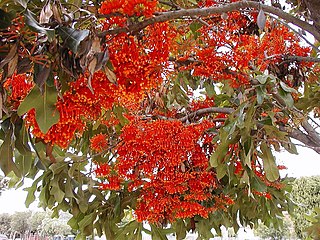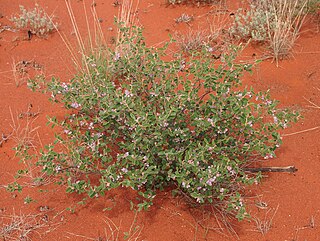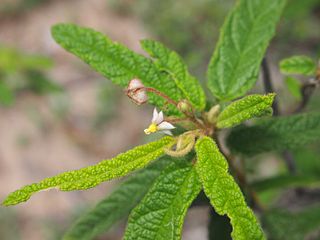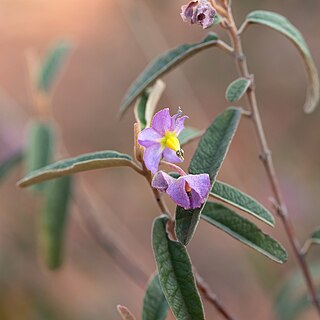
Typhonium is a genus in the family Araceae native to eastern and southern Asia, New Guinea, and Australia. It is most often found growing in wooded areas.
- Typhonium acetosellaGagnep. - Cambodia, Laos, Thailand, Vietnam
- Typhonium adnatumHett. & Sookch. - Thailand
- Typhonium albidinerviumC.Z.Tang & H.Li - Guangdong, Hainan, Laos, Thailand
- Typhonium albispathumBogner - Thailand
- Typhonium alismifoliumF.Muell. - Queensland, Northern Territory
- Typhonium angustilobumF.Muell. - Queensland, New Guinea
- Typhonium bachmaenseV.D.Nguyen & Hett. - Vietnam
- Typhonium baoshanenseZ.L.Dao & H.Li - Yunnan
- Typhonium blumeiNicolson & Sivad. - Japan, Taiwan, Ryukyu Islands, much of China, Bangladesh, Laos, Cambodia, Myanmar, Thailand, Vietnam; naturalized in Madagascar, Mauritius, Comoros, Borneo, Philippines, West Indies
- Typhonium bognerianumJ.Murata & Sookch. - Thailand
- Typhonium browniiSchott - Queensland, New South Wales
- Typhonium bulbiferumDalzell - southern India
- Typhonium circinnatumHett. & J.Mood - Vietnam
- Typhonium cochleareA.Hay - Northern Territory of Australia
- Typhonium cordifoliumS.Y.Hu - Thailand
- Typhonium digitatumHett. & Sookch. - Thailand
- Typhonium echinulatumHett. & Sookch. - Thailand
- Typhonium eliosurum(F.Muell. ex Benth.) O.D.Evans - New South Wales
- Typhonium filiformeRidl. - Thailand, Malaysia
- Typhonium flagelliforme(G.Lodd.) Blume - Guangdong, Guangxi, Yunnan, Bangladesh, Bhutan, Cambodia, India, Indonesia, Laos, Malaysia, Myanmar, Philippines, Singapore, Sri Lanka, Thailand, New Guinea, Queensland, Northern Territory
- Typhonium fultumRidl. - Thailand, Malaysia
- Typhonium gagnepainiiJ.Murata & Sookch. - Thailand, Cambodia
- Typhonium gallowayiHett. & Sookch. - Thailand
- Typhonium glaucumHett. & Sookch. - Thailand
- Typhonium griseumHett. & Sookch. - Thailand
- Typhonium hayataeSriboonma & J.Murata - Vietnam
- Typhonium huenseNguyen & Croat - Vietnam
- Typhonium hunanenseH.Li & Z.Q.Liu - Hunan
- Typhonium inopinatumPrain - India, Myanmar, Thailand
- Typhonium jinpingenseZ.L.Wang, H.Li & F.H.Bian - Yunnan
- Typhonium johnsonianumA.Hay & S.M.Taylor - Northern Territory of Australia
- Typhonium jonesiiA.Hay - Northern Territory of Australia
- Typhonium laoticumGagnep. - Thailand, Laos
- Typhonium liliifoliumF.Muell. ex Schott - Northern Territory, Western Australia
- Typhonium lineareHett. & V.D.Nguyen - Vietnam
- Typhonium listeriPrain - Assam, Bangladesh, Myanmar
- Typhonium medusaeHett. & Sookch. - Thailand
- Typhonium mirabile(A.Hay) A.Hay - Melville Island of Australia
- Typhonium neogracileJ.Murata - Assam, Bangladesh, Myanmar
- Typhonium nudibaccatumA.Hay - Western Australia
- Typhonium orbifoliumHett. & Sookch. - Thailand
- Typhonium pedatisectumGage - Myanmar
- Typhonium pedunculatumHett. & Sookch. - Thailand
- Typhonium peltandroidesA.Hay, M.D.Barrett & R.L.Barrett - Western Australia
- Typhonium penicillatumV.D.Nguyen & Hett. - Vietnam
- Typhonium pottingeriPrain - Myanmar
- Typhonium praecoxJ.Murata - Myanmar
- Typhonium praetermissumA.Hay - Northern Territory of Australia
- Typhonium pusillumSookch., V.D.Nguyen & Hett. - Thailand
- Typhonium reflexumHett. & Sookch. - Thailand
- Typhonium roxburghiiSchott - Taiwan, Yunnan, Bonin Islands, India, Bangladesh, Sri Lanka, Andaman Islands, Thailand, Malaysia, western Indonesia, Philippines, New Guinea; naturalized in Western Australia, eastern Brazil, Tanzania
- Typhonium russell-smithiiA.Hay - Northern Territory of Australia
- Typhonium sagittariifoliumGagnep. - Thailand
- Typhonium saraburiensisSookch., Hett. & J.Murata - Thailand
- Typhonium sinhabaedyaeHett. & A.Galloway - Thailand
- Typhonium smitinandiiSookch. & J.Murata - Thailand
- Typhonium stigmatilobatumV.D.Nguyen - Vietnam
- Typhonium subglobosumHett. & Sookch. - Thailand
- Typhonium tayloriiA.Hay - Northern Territory of Australia
- Typhonium trifoliatumF.T.Wang & H.S.Lo ex H.Li, Y.Shiao & S.L.Tseng - Mongolia, Hebei, Inner Mongolia, Shaanxi, Shanxi
- Typhonium trilobatum(L.) Schott - southern China, Indian Subcontinent, Indochina; naturalized in Windward Islands, Ivory Coast, Borneo, Philippines
- Typhonium tubispathumHett. & A.Galloway - Thailand
- Typhonium variansHett. & Sookch. - Thailand
- Typhonium vermiformeV.D.Nguyen & Croat - Vietnam
- Typhonium violifoliumGagnep. - Myanmar, Thailand
- Typhonium watanabeiJ.Murata, Sookch. & Hett. - Thailand
- Typhonium weipanumA.Hay - Queensland
- Typhonium wilbertiiA.Hay - Queensland

Muehlenbeckia or maidenhair is a genus of flowering plants in the family Polygonaceae. It is native to the borders of the Pacific, including South and North America, Papua New Guinea and Australasia. It has been introduced elsewhere, including Europe. Species vary in their growth habits, many being vines or shrubs. In some environments, rampant species can become weedy and difficult to eradicate.

Commersonia is a genus of twenty-five species of flowering plants in the family Malvaceae. Plants in this genus are shrubs or trees, occurring from Indochina to Australia and have stems, leaves and flowers covered with star-like hairs. The leaves are simple, often with irregularly-toothed edges, the flowers bisexual with five sepals, five petals and five stamens and the fruit a capsule with five valves. The genus underwent a revision in 2011 and some species were separated from Commersonia, others were added from Rulingia.

Centrolepis is a genus of small herbaceous plants in the family Restionaceae known as thorn grass scales, with about 25 species native to Australia, New Zealand, New Guinea, and south-east Asia as far north as Hainan Dao. APG III system classifies this genus in the Centrolepidaceae family.

Stenocarpus is a genus of about 22 species of flowering plants in the family Proteaceae. They are trees or shrubs with variably-shaped leaves, zygomorphic, bisexual flowers, the floral tube opening on the lower side before separating into four parts, followed by fruit that is usually a narrow oblong or cylindrical follicle.

Xanthostemon is a genus of plants in the myrtle family Myrtaceae, first described in 1857 by the German–born Australian botanist Ferdinand von Mueller. The genus is distributed across Malesia, Papuasia and northern Australia. The genera Pleurocalyptus and Purpureostemon from New Caledonia are morphologically close to Xanthostemon.

Lasiopetalum, commonly known as velvet bushes, is a genus of about forty-five species of flowering plants in the family Malvaceae, all endemic to Australia.

Trianthema is a genus of flowering plants in the ice plant family, Aizoaceae. Members of the genus are annuals or perennials generally characterized by fleshy, opposite, unequal, smooth-margined leaves, a prostrate growth form, flowers with five perianth segments subtended by a pair of bracts, and a fruit with a winged lid. The genus contains about 30 described species growing in tropical and subtropical regions, especially Australia. One common species, Trianthema portulacastrum, desert horse purslane, is frequent as a weed in agricultural areas and is widely distributed.

Comesperma is a genus of shrubs, herbs and lianas in the family Polygalaceae. The genus is endemic to Australia. It was defined by the French botanist Jacques Labillardière in his 1806 work Novae Hollandiae Plantarum Specimen. The genus name is derived from the Ancient Greek words come ("hair") and sperma ("seed"), and relates to the seeds bearing tufts of hair. The genus is distributed over southern Australia, particularly in the southwest of Western Australia, where 19 species are found. 24 species have been described.

Dipodium, commonly known as hyacinth orchids, is a genus of about forty species of orchids native to tropical, subtropical and temperate regions of south-east Asia, New Guinea, the Pacific Islands and Australia. It includes both terrestrial and climbing species, some with leaves and some leafless, but all with large, often colourful flowers on tall flowering stems. It is the only genus of its alliance, Dipodium.

Caesia is a genus of herbs in the family Asphodelaceae, subfamily Hemerocallidoideae, native to Australia, New Guinea, Madagascar and Southern Africa. The mostly 3-lobed seed capsules contain rounded black seeds. The genus was named in honour of Federico Cesi (1585-1630), an Italian scientist.
Rulingia is a genus of flowering plants native to Australia and Madagascar. In 2011, all species were transferred to Commersonia with the exception of Rulingia cuneata, R. loxophylla, R. luteiflora and R. procumbens which have been transferred to the new genus Androcalva.

Anisomeles is a genus of herbs of the family Lamiaceae and is native to China, the Indian Subcontinent, Southeast Asia, New Guinea, Australia, Madagascar, and some Pacific and Indian Ocean islands. Plants in the genus Anisomeles have small, flat, narrow elliptic to narrow e.g.-shaped leaves arranged in opposite pairs, the edges of the leaves sometimes wavy or serrated. The flowers are arranged in groups, with five sepals and five petals in two "lips", the lower lip with three lobes, the middle lobe much longer than the side lobes. There are four stamens that extend beyond the petals and a single style in a depression on top of the ovary. The fruit is a schizocarp with four nutlets containing small seeds.

Androcalva is a genus of 33 species of flowering plants in the family Malvaceae and is endemic to continental Australia.

Haemodorum is a genus of herbs in the family Haemodoraceae, first described as a genus in 1798 by James Edward Smiith. The genus is native to New Guinea and Australia. The type species is Haemodorum corymbosum Vahl, first described by Martin Vahl in 1805.

Seringia nephrosperma is a shrub of the family Malvaceae. It is native to Australia, where it grows in deserts and dry shrublands in New South Wales, Northern Territory, Queensland, South Australia, and Western Australia.

Seringia corollata is a species of flowering plant in the family Malvaceae and is endemic to north-eastern Australia. It is a small, low-growing shrub with hairy young branches, egg-shaped to lance-shaped leaves and mauve flowers arranged singly or in groups of up to 3.

Seringia velutina, the velvet firebush, is a shrub in the Malvaceae family native to Western Australia.

Seringia exastia, also known as fringed fire-bush, is a species of flowering plant in the mallow family and is endemic to northern Western Australia. It is an erect, compact shrub with hairy young branches, narrowly egg-shaped, elliptic or oblong leaves and purple flowers arranged in groups of 7 to 9.

Seringia collina is a species of flowering plant in the family Malvaceae and is endemic to Queensland. It is a low growing, small rounded shrub with hairy branches, oblong to egg-shaped leaves and usually purple flowers in groups of 3 to 6.



















